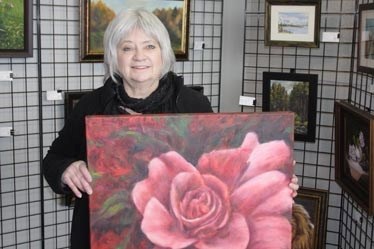Leafing through an album of Maureen Flinn’s work is like seeing a succession of stills from one of Sergio Leone’s Spaghetti Westerns.
There are rugged landscapes, creeks, lakes, waterfalls, derelict buildings, grain elevators, sheep and cattle.
You can almost taste the grit, feel the heat or chill on rocks and stones, and catch the raw scent of vegetation. You almost wish you could sluice your face in a creek and wipe away the sun’s rays.
When Flinn says she and her husband, Dale, own land in Texas and are captivated by the weathered, tough terrain, you feel you already know it.
Some of the painting titles tell their own “Ol Canteena,” “Rio Grande,” “Cowboy Way,” “Sunday Silence,” “Just Grazin,” and “Crooked Pine.”
It would not be surprising to see Clint Eastwood stride out of a painting in hobnailed boots, cheroot smoke curling under a broad-rimmed hat, and an inscrutable expression on his grimy, bestubbled face.
Turn more pages of Flinn’s album and other movie genres come to mind, other eras.
There is a painting called “Rainy Days” of a 1937 Pontiac left in a scrubby woodland area west of Bowden, Alberta. It could be a scene from Bonnie and Clyde, a worn-out getaway car hastily abandoned, now part of the environment.
A painting of gardening tools carries a similar sense of something manmade absorbed into rustic surroundings, something detached from the glare of modernity.
This mood of a bygone age is created by soft tones that imbue much of Flinn’s work with restfulness, perhaps even a yearning for a simpler time.
“I like autumn colours because they are warm,” says Flinn. “I like rust. I also like brown, orange and beige.”
Go to her website (www.maureenflinn.com) and you will see the same colour preference, a sepia, olive and cream banner.
What Flinn’s album cannot get across is the size of her work. She likes paintings so large that the viewer is invited to enter them.
So far, her biggest one is a 7 ft. by 4 ft. painting showing the evolution of Eleanor Hall School in Clyde. A commissioned work, it features a portrait of a resolute-looking Eleanor Hall, surrounded by the school in various stages of its development. It took about six weeks to complete.
“All my pictures are quite big,” Flinn says. “I have done paintings 6 ft. by 3 f.t and 4 ft. by 3 ft. But Eleanor Hall is the biggest. I like the impact of a big painting.”
Born in Enderby, British Columbia, Flinn exhibited an early flair for art: she was constantly drawing and pencil sketching as a child.
Her father being a woodworker and her mother a seamstress, Flinn inherited their craft talents, doing ceramics, pottery, decoupage, and tole painting (folk art of decorative painting) on wooden objects, cream cans and coal shuttles.
She met Dale Flinn and moved north of Edmonton to a small town called Dapp. It was not until about 10 years ago that she allowed her innate artistry to flower.
“I saw something on television about Pro’s Art School and Gallery in Edmonton and thought it sounded interesting, so I went along to a class,” she says. “I still go there every Wednesday.”
At Pro’s Art, she was introduced to oils – her favourite medium, although she has tried acrylics and worked with a palette knife – and was taught the method and techniques used by master artists.
In 2005 she visited New York with instructor Gene Prokop and fellow painters to view some masters’ great paintings. Her website describes the experience.
“Experiencing the movement and life in an oil painting done by a master was exhilarating and she was eager to delve into further learning of how the masters were able to make the paintings come alive through their use of big and bold brushstrokes.”
Flinn, a member of the Alberta Community Art Club Association and art clubs in Barrhead and Westlock, uses a two-inch brush.
“I work very quickly,” she says. “I do a good base coat and then go from there. If you have the drawing right and the first coat is right, then you are off to the races.”
Over the years she has learned to loosen up her brushstrokes to the point of spontaneity.
“I just do what the heart tells me,” she says. “I go with the flow.”
Once she is done, there is very little finessing and tweaking.
Although nature and animals are probably her primary source of inspiration, Flinn has ventured into portraits.
“I have painted my five grandchildren,” she says. “I’ve done three portraits of each of them.”
Over the last 10 years Flinn has been on an eventful artistic journey, which has seen her sell work, get commissions, participate in shows and teach art in Westlock. This Friday, people can go to Barrhead’s Art Gallery to see how far she has come. As Barrhead Art Club’s featured artist of the month she will be present to answer questions about her work.
“I’ve learned a lot from my fellow artists and teachers,” she says. “I am comfortable where I am right now and want to keep learning.”
Flinn closes her album.
As she does so, credits roll down an imaginary movie screen, lights come on in an imaginary theatre.
The show is over.



